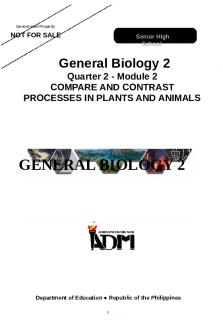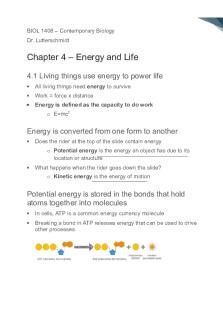General Biology 2 - Energy in Life PDF

| Title | General Biology 2 - Energy in Life |
|---|---|
| Author | Esme |
| Course | General Biology II |
| Institution | Dawson College |
| Pages | 27 |
| File Size | 2.4 MB |
| File Type | |
| Total Downloads | 19 |
| Total Views | 126 |
Summary
The terms ChemotrophPhototroph reflects different ways of and obtaining __________. How do each obtain their energy? Can Chemotrophs you Identify the in this terrestrial phototrophs? ecosystem? Energy is transformed as it flows through ecosystems. Enters as radiant energy and exits as thermal energy...
Description
The terms Phototroph and Chemotroph reflects different ways of obtaining __________ . How do each obtain their energy? Can you Identify the phototrophs? Chemotrophs in this terrestrial ecosystem?
2
• Energy important for life can exists in many forms: 1. Radiant Energy 2. Chemical Energy 3. Thermal Energy 4. Mechanical Energy 5. Electrical Energy Review: Many of these can exist as potential or kinetic energy. What is the difference?
3
• Energy is transformed as it flows through ecosystems. • Enters as radiant energy and exits as thermal energy. • Processes in organisms are subject to the laws of thermodynamics.
4
What is the first law of thermodynamics? Energy can be ___________ or ___________ but cannot be ___________ or ___________ . What is the second law of thermodynamics? As energy is transformed, some energy is converted to ___________ energy as the entropy (disorder) of the system ___________ . How do these laws relate to biological systems? Heat
(Unusable Energy)
Sugars
Chemical energy
(a) First law of thermodynamics
ATP (Usable Energy)
(b) Second law of thermodynamics
↑ in Entropy
5
• Organisms use energy to power biological _____ . • What kinds of _____ do organisms carry out? A. Synthesizing molecules to build complex structures and to reproduce. B. Movement of the body, cells, and substances within cells. C. Transport of chemicals across the cell membrane.
6
________ work ________ work
________ work 7
• Biological work is accomplished by coupling a spontaneous process to a nonspontaneous process.
8
• A process is spontaneous if it proceed on their own, without any added energy.
(a) Gravitational motion
(b) Diffusion
(c) Chemical reaction 9
• The spontaneity of a process is determined by 2 factors: 1.The change in potential energy. 2.The change in the degree of order.
10
1. Processes tend to be spontaneous if the end state has lower potential energy than the starting state. 2. Processes tend to be spontaneous when the end state is less ordered than the starting state. 11
12
• Can we predict if a process is spontaneous or nonspontaneous? • To determine this, it’s necessary to assess the combined contributions of changes of potential energy and changes in disorder. • We do this with a quantity called Gibbs free-energy change, symbolized by DG:
DG = DH - TDS H stands for Enthalpy S represents Entropy T represents Temperature (in Kelvin). The TDS term simply means that entropy (S) becomes more important in determining free-energy change as the temperature of the molecules increase.
13
• DG < 0: Process is exergonic (spontaneous) • DG > 0: Process is endergonic (nonspontaneous) • DG = 0: Process is at equilibrium 14
(a) Exergonic reaction: energy released, spontaneous
Reactants Amount of energy released (Δ ΔG < 0)
Free energy
• Exergonic Process: represents the energy available to carry out work when a process occurs.
Energy Products
Progress of the reaction
(b) Endergonic reaction: energy required, nonspontaneous Products
Free energy
• Endergonic Process: represents the energy required to carry out a process.
Amount of energy required (Δ ΔG > 0) Energy Reactants
Progress of the reaction
15
• ATP hydrolysis is usually the exergonic process used to drive an endergonic process in energy coupling. • ATP acts as the energy currency in cells.
Energy can be used to power an endergonic process. 16
ΔG < 0
• Can be used to carry out work. • Proceed towards equilibrium (DG=0)
17
Work is carried out
ΔG < 0
Work stops
ΔG = 0
(a) An isolated hydroelectric system A spontaneous process reaches equilibrium in a close system and work stops.
18
ΔG = 0
• Forward process occurs at the same rate as the reverse process. • Le Châtelier’s Principle: Equilibrium can be disturbed (or prevented) by changing parameters. 19
CO2(g) + H2O (l) çè H2CO3 (aq) What would happen if you: 1. Remove CO2 from this system? 2. Add H2CO3?
20
Add Reactants
(b) An open hydroelectric system
Work is carried out
ΔG < 0
A spontaneous process does not reach equilibrium in a open system and work continues.
Remove Products
21
• Chemical reactions in cells do not reach equilibrium (DG=0). • Reactants and products are maintained at steady-state (stable) concentrations not equilibrium concentrations so reactions are exergonic (DG...
Similar Free PDFs

General Biology 2 - Energy in Life
- 27 Pages

General Biology 2 - Carbon in Life
- 28 Pages

General Biology I Chapter 2
- 3 Pages

General Biology 2 Quarter 2 Module 2
- 52 Pages

Chapter 4 - Energy and LIfe
- 14 Pages

General Biology Module
- 241 Pages

General Biology Notes
- 19 Pages

General Biology Lecture 1
- 2 Pages

Lab Report 1 for general biology 2
- 13 Pages

General Biology 1-STEM
- 190 Pages
Popular Institutions
- Tinajero National High School - Annex
- Politeknik Caltex Riau
- Yokohama City University
- SGT University
- University of Al-Qadisiyah
- Divine Word College of Vigan
- Techniek College Rotterdam
- Universidade de Santiago
- Universiti Teknologi MARA Cawangan Johor Kampus Pasir Gudang
- Poltekkes Kemenkes Yogyakarta
- Baguio City National High School
- Colegio san marcos
- preparatoria uno
- Centro de Bachillerato Tecnológico Industrial y de Servicios No. 107
- Dalian Maritime University
- Quang Trung Secondary School
- Colegio Tecnológico en Informática
- Corporación Regional de Educación Superior
- Grupo CEDVA
- Dar Al Uloom University
- Centro de Estudios Preuniversitarios de la Universidad Nacional de Ingeniería
- 上智大学
- Aakash International School, Nuna Majara
- San Felipe Neri Catholic School
- Kang Chiao International School - New Taipei City
- Misamis Occidental National High School
- Institución Educativa Escuela Normal Juan Ladrilleros
- Kolehiyo ng Pantukan
- Batanes State College
- Instituto Continental
- Sekolah Menengah Kejuruan Kesehatan Kaltara (Tarakan)
- Colegio de La Inmaculada Concepcion - Cebu





